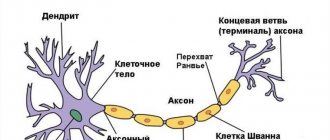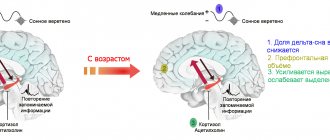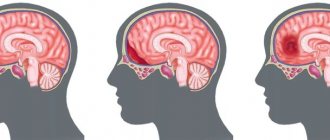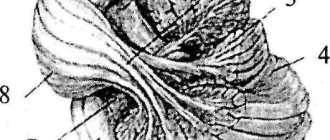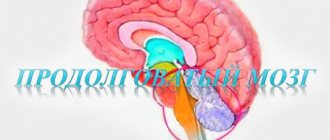What main brain structures are responsible for healthy sleep?
The central structure responsible for the processes of sleep and wakefulness is the reticular formation, located in the medulla oblongata and the medial part of the pons.
The center of wakefulness - the reticular nuclei of the bridge, capture various stimuli from the external environment and with sufficient intensity of external signals (an alarm clock or bright sunlight) we wake up.
The main center of sleep is the central gray matter of the midbrain, the raphe nuclei containing serotonin neurons, which, with the help of the neurotransmitter of the same name (serotonin), remove unnecessary information flows in the brain, after which GABA neurons (gamma-aminobutyric acid - the main inhibitory neurotransmitter of the central nervous system) come into play. , which intensively block visual, auditory and other stimuli, this effect is consolidated by special structures - the nuclei of the thalamus.
Thus, in the central nervous system there is competition between the systems responsible for sleep and wakefulness. The main centers of wakefulness use glutamic acid as a mediator, which activates the central nervous system.
In the process of transition from sleep to wakefulness, an important role, in addition to the reticular formation, is played by the locus coeruleus, a structure located in the anterior upper part of the pons that actively secretes norepinephrine. Norepinephrine has both inhibitory and stimulating effects on the nervous system, depending on which brain structure is affected. To understand the processes of activation of the central nervous system, it is important to know that it acts on the central gray matter as an inhibitory transmitter, thus neutralizing the “hypnotic” effect of this structure on the body. Activation of the locus coeruleus leads to the “awakening” of the nervous system. The locus coeruleus becomes inflamed during periods of stress and danger. It is this structure that is responsible for sleepless nights before an exam, interview and other subjectively disturbing events.
In parallel with this, there is a system that recognizes the time of day (day/night), which further interacts with the centers of sleep and wakefulness - the suprachiasmatic nuclei of the hypothalamus. Disturbances in the processes of falling asleep and waking up after long flights, the so-called jet lag, is the process that this system requires to adapt to changing time zones.
Why does our body need sleep? What is its function?
It is reliably known that during night sleep, important hormonal substances are synthesized and released, body temperature and heart rate decrease, which contributes to the overall restoration of the body.
We will focus on the benefits that sleep has on nervous system function.
One of the key bonuses is sorting the information accumulated during the day into important and unimportant and the process of “erasing” the latter.
Why is it important?
During the day, the human brain processes a large amount of information, thus, new neural connections are formed in the central nervous system, which is accompanied by activation of synaptic transmission between neurons, as well as serious expenditure of energy resources. The bottom line is that most of these information channels are not important, as is the information imprinted in them, therefore, during night sleep, cell walls are restored and synapses are inactivated, which is accompanied by the “erasing” of some of the information accumulated during the day. In other words, neurons are freed from excess load so that in the morning we can study and work again with a “fresh head.”
Also, during sleep, those neurons that were inactive during the day are activated, thus the central nervous system adjusts itself so that all nerve cells are in good shape and ready to start working at any moment. This mechanism also ensures the stability of old memories - information about childhood, school and college knowledge, etc.
In general, sleep has a huge positive effect on memory and neuroplasticity - the ability to form new neuronal connections.
Sleep deprivation is deadly
In the 20th century, a genetic disease called “fatal familial insomnia” was discovered: it caused the death of members of more than 30 families around the world. The symptoms are the same. At first, people stopped sleeping - it simply didn’t work, then the pulse quickened and the pressure increased, in the next phase the patients could not speak, stand or walk. It all ended in a couple of months: before death, people fell into a state similar to a coma and died. As a rule, the disease affects middle-aged people and sometimes teenagers.
Article on the topic
How to fall asleep correctly so that you are alert in the morning. Advice from a somnologist
Why are different sleep phases needed and how many of them should be normal?
Mammals have two stages of sleep: REM and nonREM.
REM (rapid eye movement - rapid eye movements (REM)) is the phase of sleep during which people dream, it is also called the paradoxical sleep phase. Dreams can be called a by-product of the recovery processes that occur in the brain. Scientists have found that a dream, essentially a hallucinatory activity that is normal, is nothing more than an attempt by our brain to create a more or less coherent image from various chaotic signals that are born during night sleep in the central nervous system.
What happens to the body during a dream? During REM sleep, the electrical activity of the brain practically coincides with that observed during wakefulness, while the production of a number of neurotransmitters in the central nervous system: norepinephrine, serotonin and histamine is significantly reduced. The amount of glycine and GABA also decreases, which together causes paralysis of skeletal muscles. That is why, normally, when in a dream a person imagines that he is running, swimming, fighting or performing any other active actions, in reality he is lying motionless under the blanket. Due to disruptions in the conduction of impulses and neurotransmitter activity during the REM phase of sleep, a number of disorders occur: sleepwalking - sleepwalking, sleep paralysis - situations when a person wakes up, but cannot move.
Some researchers have concluded that REM sleep is largely responsible for normal memory functioning. Its absence, accordingly, leads to serious mnestic-intellectual disorders. It is during REM sleep that important new information received during the day is repeated.
A dream is a rehearsal
Scientists are increasingly inclined to believe that the biological significance of sleep is to ensure the survival of the species, be it rat or human. In our dreams, we practice avoiding danger (which seems to be what dreams with threatening content are for), such as swimming across a river or running away from a dangerous animal. But thanks to the special state in sleep, in which our muscles are almost immobilized, all this rehearsal occurs at the level of the brain. Thus, we learn ways to save our lives in a dream so that someday we can use them in real life.
The work of the subconscious: how dreams help solve problems and identify diseases
More details
What to do if you have trouble sleeping?
It would seem that it is not surprising that such a complex system periodically fails, which is manifested by sleep disturbances. Surely every person at least once in his life has encountered one or another manifestation of insomnia that arises in connection with external events: anxiety before an exam, a hangover after a lot of fun, serious stress.
A number of sleep problems can be solved by following simple hygiene rules.
- It is necessary to reduce the amount of daytime sleep to 30 minutes or completely abandon this practice. The logic here is very simple: by getting enough sleep during the day, you knock down your circadian ri and the feeling of exhaustion in the morning.
- Avoid products containing caffeine, nicotine and alcohol after 6-8 pm. While the stimulating effect of caffeine is a well-known fact, not everyone knows about the activating effect of nicotine. The history with this connection is very ambiguous. Nicotine can act differently on one person in different situations: sometimes it activates, but at other times it gives a calming effect. So if you have trouble falling asleep, your “smoke one more before bed” habit may be to blame. In addition, there is an opinion that drinking alcohol at night can interfere with healthy and sound sleep, in this case due to early morning awakenings. By three or four in the morning, toxic products of ethanol metabolism will accumulate in the body and you will certainly not have time to sleep...
- Play sports if you want to get enough sleep. It's no secret that playing sports has a positive effect on the entire body, especially on the nervous system. But it is important to take into account the nature of the load and choose the right time of day for classes. For example, it is better to move running, aerobics and other active sports with high energy consumption to the morning. As a last resort, try to finish your workout 3-4 hours before bed. In the late evening, it will be useful to take a walk outside or take a short bike ride.
- Avoid eating at night. A heavy late dinner will not only add inches to your waist, but will also prevent you from falling asleep quickly and soundly. Even if you are hungry, it is better to have something light to eat. It also makes sense to avoid eating spicy foods and eliminating carbonated drinks from your evening diet.
- Get outdoors during the day. For the normal functioning of a person’s internal clock, which ensures the correct sleep-wake cycle, it is necessary to spend at least half an hour during the day outside, if possible in the sun. Also, recently scientific articles have been published indicating the harmful effects of fluorescent lamps; there is evidence that such unnatural lighting in some cases causes insomnia. Therefore, it is better to avoid using such lamps at home.
- Don't skimp on a good mattress and pillows. This is really very important. Years of sleeping on air mattresses and reclining chairs are sure to result in insomnia, headaches and back muscle spasms. Remember that one of the most important wealth is health.
- Create a bedtime ritual for yourself. For some, this may be a warm shower or a relaxing bath with aromatic oils, for others, light stretching exercises are best, for others, reading is best. Choose your option and let it become a habit, this will help create the right mood and prepare your body for rest.
"Circadian rhythm genes" and aging
The work of any organ is ultimately the work of its genes. Our “internal clock” is no exception. The suprachiasmatic nucleus expresses a number of genes that are inactive in other parts of the brain and body in general. These genes include BMAL1 (aka MOP3 and ARNT3), CLOCK and NPAS2 [7], [8]. These genes were identified in studies using knockout mice—those in which one or more genes have been disrupted by genetic engineering.
As a rule, life expectancy in rodents with one or more “periodicity genes” turned off is reduced. In particular, mice with disabled BMAL1 live shorter than their counterparts. At the end of their lives, they show all the characteristic signs of aging: their organs decrease in size, muscle mass and subcutaneous fat are lost, senile cataracts develop, and the content of reactive oxygen species in tissues increases [9]. With a constant lack of BMAL1 and CLOCK proteins, memory deteriorates and intelligence decreases: animals learn worse and forget new information faster [10].
BMAL1 and CLOCK act differently: if you turn off the CLOCK gene without affecting BMAL1, the lives of mice undergo less global changes. The average lifespan of rodents without CLOCK is 15% shorter than that of wild-type animals, and premature aging manifests itself only in changes in the structure of the skin and the development of cataracts [11].
The changes described above occur at the level of individual organs. But organs are made of cells, and the real action always takes place there first. So it makes sense to look at what "circadian rhythm genes" do at the cellular level. Most of their effects can be classified into one of several categories (Fig. 3).
Here is one example of the connection between circadian rhythms and metabolism in general: “A connection has been found between metabolism and circadian rhythm” [12].
Figure 3. Examples of manifestations of aging at the cellular level. A detailed explanation of these manifestations is given below in the text in the form of a numbered list.
- Cell cycle change. The cell cycle is the alternation of stages of cell growth and division. Different types of cells divide at different rates, and this rate is not random. The daily routine of cells follows circadian rhythms. If the latter for some reason (for example, due to long working hours or as a result of aging) go astray, the likelihood of untimely cell division increases, and with it the likelihood of tumor formation increases [13]. The biochemical processes that control the change in stages of the cell cycle depend on enzymatic reactions that ensure the manifestation of circadian rhythms. Therefore, if the latter are violated, the former will also suffer. For example, a cell may begin to divide, although it should no longer do so. But uncontrolled division is a sign of a cancer cell.
- Genome instability. The inconsistent composition of DNA in a cell does not bode well. Genome instability means an increased number of mutations and an increased likelihood of malignant degeneration of the cell. Of course, there are a number of mechanisms that counteract genomic instability. This is, for example, the action of the SIRT6 protein [9] (by type of activity it is an NAD-dependent deacetylase). It also controls the functioning of the BMAL1 and CLOCK proteins [10]. In turn, changes in their activity have a direct impact on SIRT6, and therefore on genome stability. Mice lacking SIRT6 die very quickly, at four weeks of age. At the same time, they look unimportant: they lose muscle mass, their backs become hunched, the number of lymphocytes in the blood decreases, and at the same time their immunity deteriorates. Once again we see signs characteristic of old animals.
- Decreased telomerase activity. Telomerases are enzymes that prevent shortening of telomeres—nonsense DNA fragments located at the ends of chromosomes that protect “meaningful” genes closer to the center of these chromosomes from disappearing. Before a cell can divide, its chromosomes must double. But due to the peculiarities of the mechanism of such doubling, the chromosomes are shortened a little at the ends each time. For the time being, their genes protect telomeres from damage. After about 50 divisions, telomeres become so short that they virtually disappear. After this, gene damage begins, and with it cell mutations and aging. The activity of telomerase complexes and their components, in particular a protein called TERT, depends on circadian rhythms. The expression of telomerase complex mRNA is directly regulated by the CLOCK and BMAL proteins (they are combined into a single molecule called a heterodimer) [14]. Apparently, this is why mice deficient in the CLOCK protein have shorter telomeres and, as a result, a shorter lifespan: their telomerase functions worse.
- Epigenetic modifications of various genes. Not only the composition of genes is important, but also where, when and how intensively the proteins they encode are formed. To make a gene more or less accessible for transcription (reading information, that is, translating it into RNA form), you need to either methylate it or deacetylate the histones around it. As a rule, methylation suppresses gene expression (i.e., fewer proteins encoded by this gene are ultimately produced), and deacetylation of histones, on the contrary, enhances (DNA is wound around histones, and when the density of this “winding” weakens, it becomes easier to read the nucleotide sequence) . Histone deacetylase SIRT1 enhances the expression of the BMAL1 and CLOCK genes. And they, as we remember, are involved in the regulation of circadian rhythms. Their activity decreases with age. Perhaps this provides feedback to SIRT1, resulting in changes in its expression. Bottom line: with age, the availability of many genes changes, and this cannot but affect the functions of the body [15].
- Loss of proteostasis. The constancy of the internal environment of the body (homeostasis) is one of the signs that this organism is still alive. The internal environment includes proteins too. Each protein must be present in a certain concentration, and its molecules must be “folded” in a certain way. The ideal state of proteins in the body is called proteostasis. With age, the ability of cells to neutralize foreign substances and metabolic products and neutralize the consequences of improper protein folding decreases. Part of the detoxification processes that take place in liver cells is regulated by circadian transcription factors (controllers of RNA synthesis) PAR-bZip [16]. That is, with age, when circadian rhythms are disrupted, the ability to proteostasis decreases, because it is controlled by circadian transcription factors.
- Nutrient recognition. The TOR (target of rapamycin) metabolic pathway helps to understand whether there is something edible in the cell’s environment. The biochemical reactions in this pathway are too intense in diabetes and other metabolic disorders, as well as in... yes, you guessed it: mice lacking the BMAL1 gene. Their lifespan is reduced, but it can be increased by 50% by administering the TOR pathway inhibitor rapamycin [17].
- The work of mitochondria. Mitochondria constantly undergo oxidation and reduction reactions, and they serve as the main source of energy for most cells. One of the main roles in these processes is played by the NAD+ metabolic pathway. Its work directly depends on circadian rhythms. In particular, in mice lacking the BMAL1 gene, energy metabolism in mitochondria is impaired [18].
- Depletion of the stem cell pool. Circadian rhythms maintain the balance of self-renewal of many stem cells. They also regulate whether stem cells differentiate into other cell types. This balance is very important. If stem cells give rise to their own kind too rarely, the body slowly recovers from damage. If stem cells divide very often, their abilities may be exhausted prematurely. The tissues of various organs will cease to renew themselves effectively, and then aging will manifest itself. Interestingly, the work of different genes affects the division of stem cells differently. In mice lacking the BMAL1 gene, the number of resting stem cells is increased (plus epidermal aging begins early), while in mice lacking the Period1/Period2 genes, the opposite is true: the number of non-dividing stem cells is reduced [19].
- Intercellular communication. It must be admitted that little is still known in this area. True, it is already clear from experiments with very old mice that with age the synchronization of the functioning of neurons in the suprachiasmatic nucleus is disrupted. The disruption occurs at the level of nerve contacts [20]. Cells cannot work in concert because they lose the ability to transmit or perceive signals from their neighbors (or perhaps both). Since we are talking about the “sleep center,” it is clear why sleep worsens in old age: SCN neurons simply can no longer communicate with each other.
- Salt metabolism and blood pressure. Mice lacking the Cry2 (cryptochrome-2) gene have abnormally high blood pressure. It depends especially strongly on the salt content in the body, because... such rodents produce huge amounts of aldosterone, a hormone that causes the retention of water and sodium ions in body fluids [21]. This would not matter to the sleep narrative were it not for the fact that Cry2 is a gene that influences circadian rhythms [22].
Studies are usually conducted on large groups of animals and data are averaged across these animals. But we remember that each organism has its own unique genome, and a lot depends on how the genes in its composition interact with each other. The functioning of the same CLOCK may be impaired in two mice, but at the level of individual organs and the organism as a whole, this disorder will manifest itself in completely different ways. Yes, even if everything is fine with gene variants, two organisms will not age the same way. The fact is that the genotype of a particular organism also plays a role in the strength and nature of changes in sleep with age. This was confirmed by studies in mice [23], [24], in which the quality of sleep of rodents was assessed using electroencephalograms, and also how their vision deteriorated with age.
Laboratory mice come in several lines (this concept is quite close in meaning to the term “breed”), and each line has its own designation of numbers and letters. Rodents of the same line were born as a result of crossing close relatives. They are similar to each other both externally and internally - both in genotype and phenotype. The most commonly used mice are C57BL/6, DBA/2J, AKR/J and some others.
This is also true for rats: “A special purpose rodent” [25].
Rodents of the C57BL/6 line are more likely than others to develop cataracts with age, which means their vision almost disappears. Apparently, this is why in old age (at about a year old) these crepuscular animals become more and more active during daylight hours and less and less active in the dark. In addition, elderly C57BL/6 are awake the longest, while AKR/J sleep the longest. DBA/2J mice spend the most time in REM sleep, and AKR/J mice spend the least amount of time. If one-year-old mice of these three strains are disturbed from sleeping for a while, and then given the opportunity to get enough sleep, then the C57BL/6 rodents return to their normal routine the fastest.
What to do if you constantly worry about insomnia?
When problems arise in the short term (1-2 days), there is nothing catastrophic about it.
But if you constantly count sheep in the evenings and reach a hundred in your calculations, or jump up before the alarm clock with a swarm of thoughts in your head, then the situation is very serious and requires the intervention of a specialist.
